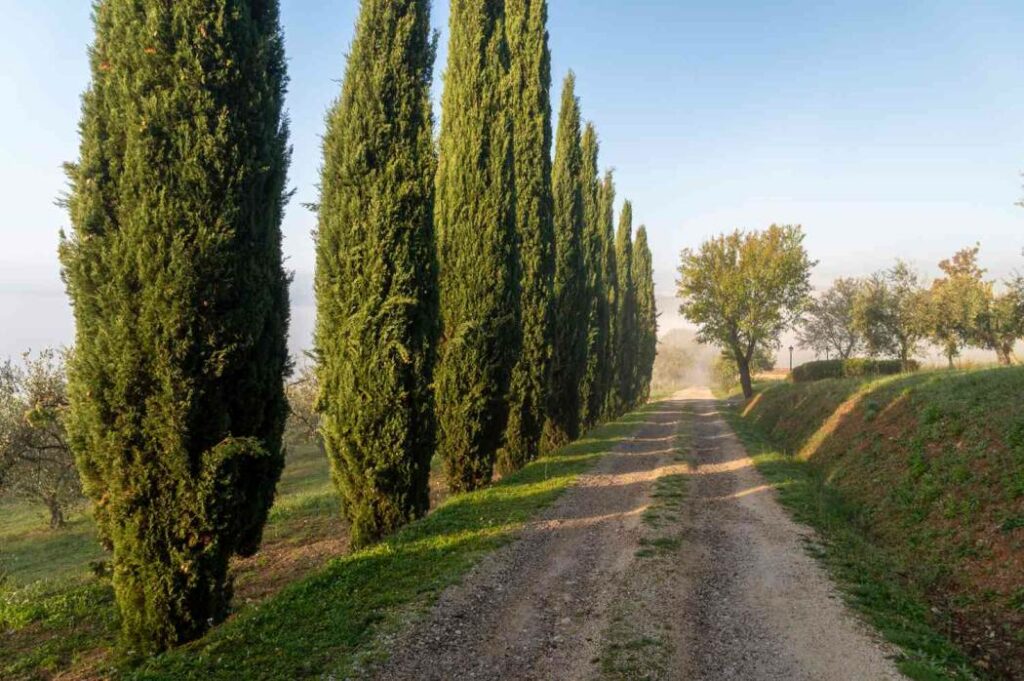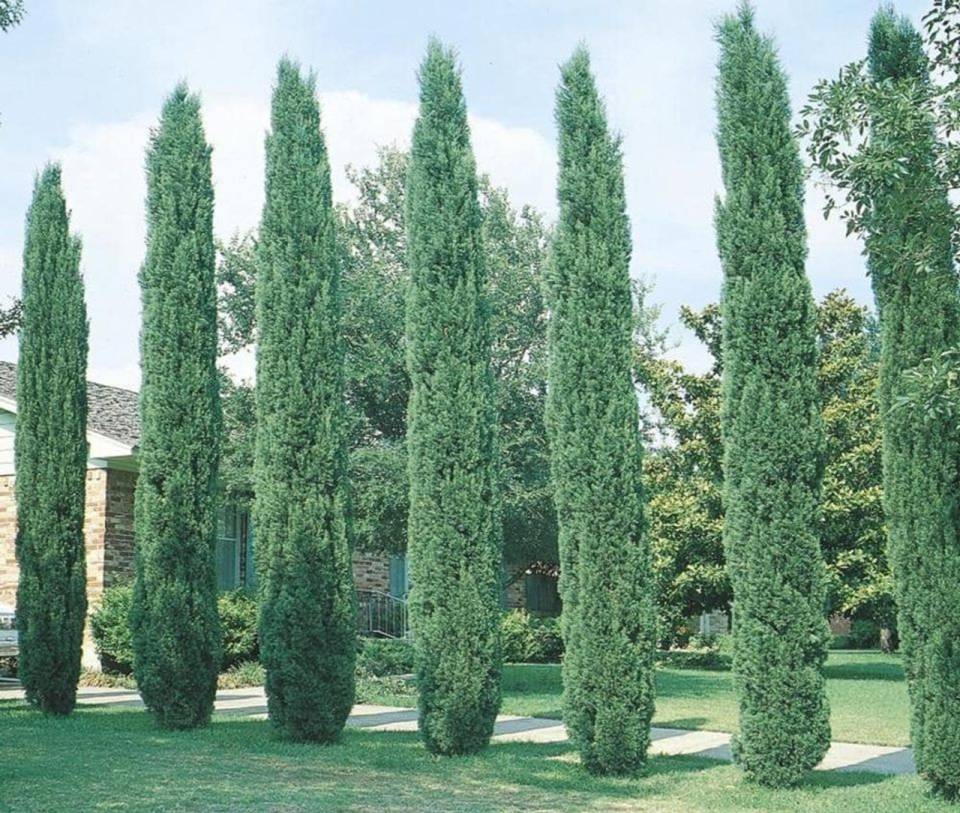Italian Cypress Tree: How to Plant, Grow, and Care

What is Italian Cypress?
Italian Cypress, known scientifically as Cupressus sempervirens, is a fascinating tree species that hails from the eastern Mediterranean region. Its strikingly tall, slender, and columnar form sets it apart from most other tree species, making it an iconic symbol of Italian landscapes, particularly in Tuscany.
The beauty of Italian Cypress isn’t merely skin-deep. This evergreen tree, which can grow between 40-60 feet tall, is adorned with small, scale-like leaves and round cones, adding to its aesthetic appeal. But it’s not just about looks. The tree’s dense foliage serves as an excellent windbreak and privacy screen, making it a practical choice for many homeowners and landscapers.
Italian Cypress thrives under full sun exposure, and it’s highly tolerant of drought conditions, reflecting its Mediterranean roots. It prefers well-drained, neutral to slightly acidic soils, but this versatile tree can adapt to various soil types, including sandy and loamy soils.
One of the remarkable aspects of Italian Cypress is its low maintenance needs. A little pruning to maintain its shape and occasional watering are typically all it requires. Furthermore, the tree attracts birds, providing a safe haven for our feathered friends.
In addition to its functionality, Italian Cypress is also steeped in history and symbolism. It has been used in religious and funerary contexts in several cultures, symbolizing death, mourning, and eternal life. Today, these trees continue to inspire with their resilience, elegance, and timeless beauty.
In essence, the Italian Cypress is more than just a tree. It’s a testament to nature’s versatility, a beacon of the Mediterranean spirit, and a living sculpture that enhances any landscape it graces. Whether you’re a gardener, a bird-watcher, or simply a nature lover, the Italian Cypress holds something special for everyone.
Fast Facts About Italian Cypress
| Attribute | Detail |
|---|---|
| Common Name | Italian Cypress |
| Botanical Name | Cupressus sempervirens |
| Family | Cupressaceae |
| Plant Type | Tree |
| Genus | Cupressus |
| Mature Height | 40-60 feet |
| Mature Width | 3-6 feet |
| Sun Exposure | Full Sun |
| Soil Type | Well-drained, sandy, or loamy |
| Soil pH | Neutral to slightly acidic |
| Soil Drainage | Well-draining |
| Bloom Time | Non-flowering |
| Attracts | Birds |
| Maintenance | Low; primarily pruning |
| Water Needs | Moderate |
| Native Area | Eastern Mediterranean |
| Drought Tolerance | High |
| Characteristics | Tall, columnar shape; evergreen; produces cones |
| Suggested Use | Windbreaks, privacy screens, ornamental landscaping |
| USDA Hardiness Zone | 7-10 |

How to Plant and Grow Italian Cypress
Ideal Location & Soil for Italian Cypress
Italian Cypress trees, with their strikingly tall and slender form, are ideally suited for full sun exposure. This means they thrive best in locations where they can soak up the sun for at least six hours each day. Therefore, when considering a location for planting Italian Cypress, open areas with minimal shade from other trees or structures are ideal.
In terms of soil, these Mediterranean natives prefer well-drained conditions. They thrive in sandy or loamy soils that allow water to percolate through easily, preventing waterlogging and root rot. The soil pH should ideally be neutral to slightly acidic.
However, one of the strengths of the Italian Cypress is its adaptability. While it has its preferences, it can tolerate a range of soil types, including clay, as long as good drainage is ensured. Keep in mind that Italian Cypress trees can grow up to 60 feet tall, so overhead space is a key consideration when choosing a planting location.
Avoid areas with overhead power lines or structures that might interfere with the tree’s upward growth. Also, consider the mature width of the tree (3-6 feet) when determining its distance from buildings or other permanent structures.
In essence, the ideal location and soil for Italian Cypress combine plenty of sun, good drainage, and enough overhead and lateral space to accommodate this majestic tree’s mature size.
Planting Time & Instructions
- Choose the best time: The optimal periods for planting Italian Cypress trees are early spring or fall.
- Prepare the hole: Dig a hole that is twice as wide and as deep as the root ball of your tree.
- Position the tree: Place the tree in the hole, making sure the top of the root ball is level with the surrounding soil surface.
- Backfill the hole: Refill the hole with the excavated soil, pressing it down firmly to get rid of any air pockets.
- Water immediately: Thoroughly water the tree right after planting.
Maintenance
- Watering: These trees have moderate water needs. While they are drought-tolerant once established, they’ll need regular watering during their first growing season. Aim for about an inch of water per week, including rainfall.
- Pruning: Pruning should be done in late winter or early spring before new growth starts. Remove any dead or diseased branches and trim them to maintain the desired shape.
- Pest Control: While generally pest-resistant, Italian Cypress can sometimes be affected by pests like cypress aphids and bagworms. Regular inspections and prompt treatment with appropriate insecticides can help keep these pests at bay.
Growth & Health Tips
- Fertilizer: Apply a general-purpose slow-release fertilizer in early spring before the start of the new growth season. This will provide the trees with the necessary nutrients for healthy growth.
- Mulching: Mulch around the base of the trees can help retain soil moisture and suppress weed growth. However, keep the mulch a few inches away from the trunk to avoid rot and pest issues.
- Winterizing: In Austin, Texas, winter temperatures are usually mild enough for Italian Cypress. However, if an unusually harsh winter is forecasted, consider wrapping the trees with burlap to protect them from wind and frost damage.
Additional Tips
- Spacing: If you’re planting multiple Italian Cypress trees, space them at least 3 feet apart to accommodate their mature width and promote good air circulation.
- Patience: Remember, growing trees is a long-term commitment. Italian Cypress trees grow relatively slowly, but your patience will be rewarded with a stunning, tall, and slender addition to your landscape that offers year-round beauty and privacy.

6 Common Problems With Italian Cypress
Italian Cypress trees are generally robust and low-maintenance but they can face a few problems:
- Cypress Canker: This is a fungal disease that causes branches to die off. Yellowing foliage, followed by browning and branch death are typical symptoms. Unfortunately, there’s no effective treatment for this disease once it has taken hold. The best course of action is to remove and destroy the affected tree to prevent the disease from spreading.
- Spider Mites: These tiny pests can cause discoloration and defoliation. They can be managed with regular jet sprays of water to knock them off the tree or using a suitable insecticide.
- Root Rot: Overwatering or poor drainage can cause root rot. Symptoms include yellowing leaves and a general decline in the tree’s health. To avoid this issue, ensure your Italian Cypress is planted in well-draining soil, and don’t overwater it.
- Bagworms: Bagworms are caterpillars that feed on the tree’s needles, causing browning and defoliation. You can manually remove the bags or use an appropriate pesticide.
- Seridium Canker: Another type of fungal disease, Seridium Canker causes patches of the bark to become sunken and discolored. There is no cure, and prevention involves proper care and maintenance of the tree.
- Nutrient Deficiencies: Lack of necessary nutrients can lead to yellowing or poor growth. Regularly feeding your tree with a balanced slow-release fertilizer can help prevent this.
Remember, early detection and prompt action are key to managing these issues effectively. Regular inspection of your Italian Cypress trees can help you spot any problems before they become too serious.
What are the Different Types of Italian Cypress
| Type | Description | Height | Width | Growth Rate | Special Features |
|---|---|---|---|---|---|
| Italian Cypress (Cupressus sempervirens) | Classic variety known for its tall, slender shape. Dark green foliage. | 40-60 feet | 10-20 feet | Medium-fast | Drought-tolerant, deer-resistant |
| Tiny Tower Italian Cypress (Cupressus sempervirens ‘Monshel’) | Dwarf variety with a compact, columnar shape. Ideal for smaller spaces or containers. | 6-8 feet | 2-3 feet | Slow | Low maintenance, ideal for small gardens |
| Swane’s Golden Italian Cypress (Cupressus sempervirens ‘Swane’s Golden’) | Varietal with golden-yellow foliage. Adds a splash of color to the landscape. | 30-40 feet | 3-4 feet | Medium | Offers a unique golden color, drought-tolerant |
| Stricta Green Italian Cypress (Cupressus sempervirens ‘Stricta Green’) | Known for its dense, dark green foliage and narrow columnar form. | 40-60 feet | 3-4 feet | Medium-fast | Resistant to pests and diseases, drought-tolerant |
What Does an Italian Cypress Symbolize?
| Context | Symbolism |
|---|---|
| General | Due to its evergreen nature and longevity, the Italian Cypress is often seen as a symbol of eternity and immortality. |
| Religion | In Christianity, they are frequently planted in churchyards and symbolize the life everlasting. In some cultures, they are associated with death and the afterlife, often found in cemeteries. |
| Ancient Cultures | In ancient cultures such as Rome and Greece, the tree was associated with the gods of the underworld, symbolizing mourning and death. |
| Feng Shui | In Feng Shui, it’s believed that Italian Cypress trees bring good fortune and protect against evil spirits. |
| Romance | Their tall, slender shape is sometimes seen as a symbol of fidelity and love enduring through time. |
| Architecture | In landscape architecture, the Italian Cypress is often used to symbolize structure and formality due to their columnar shape and uniform growth. |
7 Best Italian Cypress Alternatives
| Alternative | Description | Why It’s a Good Alternative |
|---|---|---|
| Sky Pencil Holly (Ilex crenata ‘Sky Pencil’) | A narrow, upright evergreen shrub with dark green foliage. Can reach a height of 10 feet. | It retains its columnar shape without any pruning and is adaptable to a variety of soil conditions. |
| Emerald Arborvitae (Thuja occidentalis ‘Emerald’) | An evergreen tree with a pyramidal shape and rich green foliage. Grows up to 15 feet tall. | It’s a hardy tree that can tolerate a range of soil types and weather conditions. Its dense foliage provides excellent privacy. |
| Juniper ‘Skyrocket’ (Juniperus scopulorum ‘Skyrocket’) | A fast-growing, columnar evergreen with blue-green foliage. Can reach heights of 15-20 feet. | It’s extremely drought-tolerant and requires minimal maintenance, making it ideal for dry climates. |
| Slender Hinoki Cypress (Chamaecyparis obtusa ‘Gracilis’) | A slow-growing evergreen with dark green foliage. Reaches a height of 10-12 feet. | It’s a great alternative for smaller gardens due to its slower growth rate and smaller size. |
| Italian Stone Pine (Pinus pinea) | A large evergreen tree with a distinct, umbrella-like shape. Can grow up to 40 feet tall. | It offers a different shape but still provides the Mediterranean feel of the Italian Cypress. Also produces edible pine nuts. |
| Blue Arrow Juniper (Juniperus virginiana ‘Blue Arrow’) | An evergreen shrub with a narrow, upright growth habit. Grows up to 12-15 feet tall. | It’s a hardy plant with attractive blue-green foliage that adds color to the landscape. |
| Spartan Juniper (Juniperus chinensis ‘Spartan’) | A fast-growing, columnar evergreen with dark green foliage. Can reach a height of 15-20 feet. | It’s extremely drought-tolerant and adaptable, making it an excellent choice for a variety of garden conditions. |

The Pros and Cons of Italian Cypress
Pros:
- Fast Growth: Italian Cypress trees grow quickly, making them great for creating privacy screens or hedges in a short amount of time.
- Aesthetic Appeal: Their tall, slender shape and dark green foliage add a touch of elegance and formality to any landscape.
- Drought Tolerance: Once established, these trees are highly tolerant of drought, making them suitable for regions with low rainfall.
- Low Maintenance: They require minimal pruning and care once they’re established.
- Evergreen: Evergreen, keeps its color all year round, providing constant visual interest.
Cons:
- Disease Susceptibility: They are susceptible to certain diseases such as cypress canker and root rot, especially if they’re not grown in well-draining soil.
- Limited Habitat: They prefer Mediterranean climates and may not thrive in areas with harsh winters or high humidity.
- Size: They can become quite large, which might not be suitable for smaller gardens or landscapes.
- Wind Sensitivity: These trees can be damaged by strong winds, so they’re not ideal for areas prone to severe storms or high winds.
The History of Italian Cypress
The Italian Cypress, scientifically known as Cupressus sempervirens, is a species of cypress that originated in the eastern Mediterranean region, specifically Persia (now Iran) and Syria. Despite its name, the tree’s origins are not Italian but have become a significant part of Italy’s landscape over centuries.
The Italian Cypress has been cultivated for ornamental purposes since ancient times. It has a tall, evergreen structure with blue-green needles, typically found in rocky mountainous locations. This tree can grow up to 20 to 25 meters in height, making it an impressive sight in any panorama.
Besides its aesthetic appeal, the Italian Cypress has practical uses. Historically, it has been used for windbreaks and furniture. The tree’s wood is also a source of essential oils, obtained from various cypress species, including the Italian Cypress.
The Italian Cypress has played an integral role in Greco and Italian gardens, both in the past and present. The tree’s association with these gardens demonstrates its cultural significance and enduring appeal. It is still a highly valued ornamental today, planted extensively throughout the Mediterranean region.
In addition to its horticultural value, the Italian Cypress has also influenced art. Its distinct shape and symbolism have featured prominently in Tuscan Art History.
In more recent history, archaeobotanical data has shed new light on the late Holocene history of the Italian Cypress in the Italian peninsula. This research helps us understand the tree’s historical distribution and how human activity may have influenced it.
Overall, the Italian Cypress has a rich history that intertwines with human civilization, reflecting our long-standing relationship with the natural world.
Frequently Asked Questions
1. How fast do Italian Cypress Trees grow?
Italian Cypress Trees are known for their fast growth rate. Once established, they can grow around 3 feet per year. However, the growth rate varies with age and conditions. Young trees can grow 24 inches per year. The average growth rate is reported to be between 12 to 24 inches per year.
These trees can reach a mature height of well over 30 feet. In fact, some Italian cypress can grow to 70 feet tall or even taller, while only growing between 10 and 20 feet wide.
It’s important to note that these rates can vary based on environmental factors like soil quality, sunlight, and water availability.
2. What is the average lifespan of Italian Cypress?
Italian Cypress trees (Cupressus sempervirens) are known for their longevity. They can live for several centuries under ideal conditions. Some specimens have been known to live for over 1,000 years. However, in a typical garden setting where conditions might not be optimal, you can expect an Italian Cypress to live between 50 to 150 years.
Also read:





